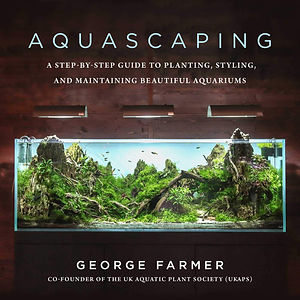
INTRODUCTION TO AQUARIUM PLANTS
So you want to aquascape? Well, you’ve come to the right place. I’ve been keeping tanks since 2002 now, and they have brought me and my family a lot of joy. I love the idea of passing the joy along to others. Planted tanks have a huge learning curve as they are comprised of many different systems, and all of these systems need to work together in harmony... similar to a car. And when you are new, you have no idea how these systems work individually or together, and that is where I come in. I am going to share my design with you as a learning platform for you to gain an understanding of what keeps plants happy and healthy!
Keeping plants healthy and happy underwater presents all sorts of challenges. However, I simplify the needs of planted aquariums into 5 pillars: lighting, nutrients, Co2, water chemistry and filtration.

Would you like a good read? Check out AQUASCAPING by George Farmer. It no only covers the basics of aquascaping, but also have loads of great imagery. It's a great gift for a new or seasoned aquascaper.
PRO TIP
My approach to keeping a planted tank focuses on what occurs naturally in the wild. By having a solid understanding of what happens naturally, we can use science and technology to push things to higher levels.
In nature, most systems are what are considered “open” systems. An example of this would be a lake that has freshwater flowing into it from several streams and rain runoff, while it releases water through constant evaporation and a small stream. In this open system, clean, nutrient-rich water flows in at all times, and older, stagnant water flows out. In this type of open system, there is an unlimited amount of clean water and nutrients readily available, and all light requirements are met via sunlight. Our planted tanks are considered “closed systems” because there is no natural exchange of light, water, or nutrients.
In order to keep a successful planted tank, we need to mimic open systems. We must simulate the conditions seen in natural “open systems”: we do frequent water changes to simulate freshwater flowing in and out, we have to dose the tank with fertilizers to make sure nutrient levels are where they need to be, and we purchase powerful lights to simulate the energy needed from the sun.
Another thing to keep in mind is that these plants are not your average house plants. Terrestrial plants (non-aquatic plants) receive loads of CO2 through the atmosphere; however, aquatic plants like the ones in our tanks aren’t exposed to the atmosphere and thus cannot use that atmospheric carbon. Understanding that carbon is scarce in a planted tank, we must ensure that our plants receive enough CO2 to do photosynthesis. I do this by injecting CO2 gas into the water via an atomizer or diffuser so that it is always available for plants during photosynthesis. This carbon injection is often referred to as “high tech”.
There are two schools of thought on keeping planted tanks: those that inject CO2, and those that do not. My approach utilizes CO2 to keep your plants happy and healthy. The key is to focus on keeping your plants happy and they'll fend off the algae! So, here begins The Aquascape Guide: Your Guide to Keeping a Planted Tank.
